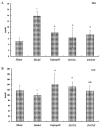Aqueous extract of dioscorea opposita thunb. normalizes the hypertension in 2K1C hypertensive rats
- PMID: 24447776
- PMCID: PMC3904168
- DOI: 10.1186/1472-6882-14-36
Aqueous extract of dioscorea opposita thunb. normalizes the hypertension in 2K1C hypertensive rats
Abstract
Background: Dioscorea opposita Thunb. (Huai Shan Yao, DOT), a common staple food in China, has been used for more than 2000 years in traditional Chinese medicine (TCM) to treat different systemic diseases including hypertension. The objective of this study was to investigate the possible antihypertensive effects of the aqueous extract of (DOT) in renovascular hypertensive rats as well as the mechanism in reducing blood pressure.
Methods: The two-kidney one-clip (2K1C) Goldblatt model of renovascular hypertension was used in Wistar rats. Rats with captopril, low-dose DOT and high-dose DOT treated 2K1C groups for 6 weeks. The blood pressure, cardiac mass index (heart weight/body weight), plasma level of angiotensin-II (Ang-II), endothelin-1(ET-1), superoxide dismutase (SOD) and malondialdehyde (MDA) were evaluated.
Results: DOT significantly reduced mean systolic and diastolic blood pressure after treatment. DOT also significantly increased plasma SOD activity but decreased plasma MDA concentration. Renal function was improved with captopril and DOT. DOT reduced plasma Ang-II activity and plasma ET concentration. They couldalso significantly reduce the left ventricular hypertrophy and cardiac mass index.
Conclusions: Our results suggest that DOT may have an antihypertensive effect on hypertension by inhibit ET-converting enzyme and antioxidant activity, which warrant further exploration.
Figures




Similar articles
-
Antihypertensive effects of Ocimum basilicum L. (OBL) on blood pressure in renovascular hypertensive rats.Hypertens Res. 2010 Jul;33(7):727-30. doi: 10.1038/hr.2010.64. Epub 2010 May 7. Hypertens Res. 2010. PMID: 20448636
-
Effects of Xin-Ji-Er-Kang formula on 2K1C-induced hypertension and cardiovascular remodeling in rats.J Ethnopharmacol. 2014 Sep 11;155(2):1227-35. doi: 10.1016/j.jep.2014.07.006. Epub 2014 Jul 23. J Ethnopharmacol. 2014. PMID: 25063306
-
Effects of traditional Chinese medicine Xin-Ji-Er-Kang formula on 2K1C hypertensive rats: role of oxidative stress and endothelial dysfunction.BMC Complement Altern Med. 2013 Jul 13;13:173. doi: 10.1186/1472-6882-13-173. BMC Complement Altern Med. 2013. PMID: 23849603 Free PMC article.
-
Vaccarin administration ameliorates hypertension and cardiovascular remodeling in renovascular hypertensive rats.J Cell Biochem. 2018 Jan;119(1):926-937. doi: 10.1002/jcb.26258. Epub 2017 Aug 23. J Cell Biochem. 2018. PMID: 28681939
-
A Frontier Review of Nutraceutical Chinese Yam.Foods. 2024 May 7;13(10):1426. doi: 10.3390/foods13101426. Foods. 2024. PMID: 38790726 Free PMC article. Review.
Cited by
-
Unravelling the Biological Activities of the Byttneria pilosa Leaves Using Experimental and Computational Approaches.Molecules. 2020 Oct 15;25(20):4737. doi: 10.3390/molecules25204737. Molecules. 2020. PMID: 33076534 Free PMC article.
-
Uncovering the genetic diversity of yams (Dioscorea spp.) in China by combining phenotypic trait and molecular marker analyses.Ecol Evol. 2021 Jul 16;11(15):9970-9986. doi: 10.1002/ece3.7727. eCollection 2021 Aug. Ecol Evol. 2021. PMID: 34367553 Free PMC article.
-
The Dioscorea Genus (Yam)-An Appraisal of Nutritional and Therapeutic Potentials.Foods. 2020 Sep 16;9(9):1304. doi: 10.3390/foods9091304. Foods. 2020. PMID: 32947880 Free PMC article. Review.
-
Cardiovascular and Renal Effects Induced by Alpha-Lipoic Acid Treatment in Two-Kidney-One-Clip Hypertensive Rats.Biomedicines. 2024 Aug 3;12(8):1751. doi: 10.3390/biomedicines12081751. Biomedicines. 2024. PMID: 39200216 Free PMC article.
-
An underutilized orphan tuber crop-Chinese yam : a review.Planta. 2020 Sep 21;252(4):58. doi: 10.1007/s00425-020-03458-3. Planta. 2020. PMID: 32959173 Free PMC article. Review.
References
-
- Arakawa K, Saruta T, Abe K, Iimura O, Ishii M, Ogihara T, Hiwada K, Fukiyama K, Fujishima M, Mizuno Y, Kikuchi T, Takaori S. Improvement of accessory symptoms of hypertension by TSUMURA Orengedokuto Extract, a four herbal drugs containing Kampo-Medicine Granules for ethical use: a double-blind, placebo-controlled study. Phytomed. 2006;13:1–10. - PubMed
-
- Herrera-Arellano A, Miranda-Sánchez J, Avila-Castro P, Herrera-Alvarez S, Jiménez-Ferrer JE, Zamilpa A, Román-Ramos R, Ponce-Monter H, Tortoriello J. Clinical effects produced by a standardized herbal medicinal product of Hibiscus sabdariffa on patients with hypertension. A randomized, double-blind, lisinopril-controlled clinical trial. Planta Med. 2007;73:6–12. doi: 10.1055/s-2006-957065. - DOI - PubMed
-
- Sinitsyna O, Krysanova Z, Ishchenko A, Dikalova AE, Stolyarov S, Kolosova N, Vasunina E, Nevinsky G. Age-associated changes in oxidative damage and the activity of antioxidant enzymes in rats with inherited over generation of free radicals. J cell Mol Med. 2006;10:206–215. doi: 10.1111/j.1582-4934.2006.tb00301.x. - DOI - PMC - PubMed
Publication types
MeSH terms
Substances
LinkOut - more resources
Full Text Sources
Other Literature Sources
Medical
Miscellaneous

